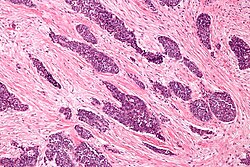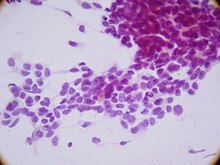Desmoplastic small-round-cell tumor
| Desmoplastic small-round-cell tumor | |
|---|---|
| Other names | DSRCT[1] |
 | |
| Micrographof a desmoplastic small round cell tumor, showing the characteristic desmoplastic stroma and angulated nests of small round cells.H&E stain. | |
| Specialty | Oncology |
| Prognosis | Five-year survival rate15%[2] |
| Frequency | ~200 cases reported[2][3] |
Desmoplastic small-round-cell tumor(DSRCT) is an aggressive and rarecancerthat primarily occurs as masses in theabdomen.[4]Other areas affected may include thelymph nodes,the lining of theabdomen,diaphragm,spleen, liver, chest wall, skull, spinal cord, large intestine, small intestine, bladder, brain, lungs, testicles, ovaries, and thepelvis.Reported sites of metastatic spread include theliver,lungs,lymph nodes,brain,skull, andbones.It is characterized by the EWS-WT1 fusion protein.
Thetumoris classified as asoft tissue sarcomaand asmall round blue cell tumor.It most often occurs in male children. The disease rarely occurs in females, but when it does the tumors can be mistaken forovarian cancer.[5]
Signs and symptoms
[edit]

There are few early warning signs that a patient has a DSRCT. Patients are often young and healthy as the tumors grow and spread uninhibited within the abdominal cavity. These are rare tumors and symptoms are often misdiagnosed by physicians. The abdominal masses can grow to enormous size before being noticed by the patient. The tumors can be felt as hard, round masses by palpating the abdomen.[citation needed]
First symptoms of the disease often include abdominal distention, abdominal mass, abdominal or back pain, gastrointestinal obstruction, lack of appetite,ascites,anemia, andcachexia.[citation needed]
Other reported symptoms include unknown lumps, thyroid conditions, hormonal conditions, blood clotting, kidney and urological problems, testicle, breast, uterine, vaginal, and ovarian masses.[citation needed]
Genetics
[edit]There are no known risk factors that have been identified specific to the disease. The tumor appears to arise from the primitive cells of childhood, and is considered a childhood cancer.[citation needed]
Research has indicated that there is a chimeric relationship between DSRCT andWilms' tumorandEwing sarcoma.Together with neuroblastoma and non-Hodgkin's lymphoma, they form thesmall-cell tumors.[citation needed]
DSRCT is associated with a uniquechromosomal translocation(notated as t(11;22)(p13:q12))[6]that merges theEWSR1FET family genenormally located onband12 of thelong (or "q" ) armofchromosome 22with part of theWT1transcription factorgene normally located on band 13 of the short arm ofchromosome 11.[7]The resultingEWSR1-WT1fusion gene is converted to afusion transcript[8]that directs the formation of an EWSR1-WT1chimeric protein.[9]The EWSR1-WT1 chimeric protein contains the N-terminaltransactivation domainofEWSR1and theDNA-binding domainofWT1.This translocation is seen in virtually all cases of DSRCT.[10]
The EWS/WT1 translocation product targetsENT4.[11]ENT4 is also known as PMAT.
Pathology
[edit]The entity was first described by pathologists William L. Gerald andJuan Rosaiin 1989.[12]Pathology reveals well circumscribed solid tumor nodules within a dense desmoplasticstroma.Often areas of central necrosis are present. Tumor cells have hyperchromatic nuclei with increased nuclear/cytoplasmic ratio.[citation needed]
On immunohistochemistry, these cells have trilinear coexpression including the epithelial marker cytokeratin, the mesenchymal markers desmin and vimentin, and the neuronal marker neuron-specific enolase. Thus, although initially thought to be of mesothelial origin due to sites of presentation, it is now hypothesized to arise from a progenitor cell with multiphenotypic differentiation.[citation needed]
Diagnosis
[edit]Differential diagnosis
[edit]Because this is a rare tumor, not many family physicians or oncologists are familiar with this disease. DSRCT in young patients can be mistaken for other abdominal tumors includingrhabdomyosarcoma,neuroblastoma,and mesentericcarcinoid.In older patients DSRCT can resemblelymphoma,peritoneal mesothelioma,and peritoneal carcinomatosis. In males DSRCT may be mistaken forgerm cellortesticular cancerwhile in females DSRCT can be mistaken for ovarian cancer. DSRCT shares characteristics with other small-round blue cell cancers including Ewing's sarcoma, acute leukemia, small cell mesothelioma, neuroblastoma,primitive neuroectodermal tumor,rhabdomyosarcoma,and Wilms' tumor.[citation needed]
Treatment
[edit]DSRCT is frequentlymisdiagnosed.Adult patients should always be referred to a sarcoma specialist. This is an aggressive, rare, fast spreading tumor and both pediatric and adult patients should be treated at a sarcoma center.[citation needed]
There is no standard protocol for the disease;[13]however, recent journals and studies have reported that some patients respond to high-dose (P6 Protocol)chemotherapy,maintenance chemotherapy,debulking operation,cytoreductive surgery,andradiation therapy.Other treatment options include:hematopoietic stem cell transplantation,intensity-modulated radiation therapy,radiofrequency ablation,stereotactic body radiation therapy,intraperitoneal hyperthermic chemoperfusion,andclinical trials.
Prognosis
[edit]The prognosis for DSRCT remains poor.[14]Prognosis depends upon the stage of the cancer. Because the disease can be misdiagnosed or remain undetected, tumors frequently grow large within the abdomen andmetastasizeor seed to other parts of the body.
There is no known organ or area of origin. DSRCT can metastasize through lymph nodes or the blood stream. Sites of metastasis include the spleen, diaphragm, liver, large and small intestine, lungs, central nervous system, bones, uterus, bladder, genitals, abdominal cavity, and the brain.
A multi-modality approach of high-dose chemotherapy, aggressive surgical resection,[15]radiation, and stem cell rescue improves survival for some patients. Reports have indicated that patients will initially respond to first line chemotherapy and treatment but that relapse is common.
Some patients in remission or with inoperable tumor seem to benefit from long term low dose chemotherapy, turning DSRCT into a chronic disease.
Research
[edit]The examples and perspective in this sectionmay not represent aworldwide viewof the subject.(July 2016) |
The Stehlin Foundation[16]currently offers DSRCT patients the opportunity to send samples of their tumors free of charge for testing. Research scientists are growing the samples on nude mice and testing various chemical agents to find which are most effective against the individual's tumor.
Patients with advanced DSRCT may qualify to participate inclinical trialsthat are researching new drugs to treat the disease.
TheCory Monzingo Foundationis a501(c)(3) organizationthat supports the research for treatments and a cure for DSRCT. The Cory Monzingo Foundation provides funding to MD Anderson Cancer Center and may also provide funding to other nonprofit cancer research organizations.
In 2002, Nishio and al,[17]established a novel human tumor cell line derived from the pleural effusion of a patient with a typical intra-abdominal DSRCT, called JN-DSRCT-1[18]that can now be used in research.
St. Jude Children’s Research Hospital has, in 2018, make available resources from the Childhood Solid Tumor Network, that upon request gives access to patient-derived orthotopic xenografts.[19]
Alternative names
[edit]This disease is also known as:desmoplasticsmall round blue cell tumor; intra-abdominal desmoplastic small round blue cell tumor; desmoplastic small cell tumor; desmoplastic cancer; desmoplastic sarcoma; DSRCT.
There is no connection toperitoneal mesotheliomawhich is another disease sometimes described as desmoplastic.
See also
[edit]- Desmoplasia
- Kate Granger(1981–2016), an English physician, whose diagnosis with DSRCT led to her campaigning for better patient care, and fund-raising for cancer research.
References
[edit]- ^RESERVED, INSERM US14-- ALL RIGHTS."Orphanet: Desmoplastic small round cell tumor".www.orpha.net.Retrieved17 November2019.
{{cite web}}:CS1 maint: numeric names: authors list (link) - ^ab"Desmoplastic Small Round Cell Tumor".St. Jude Children's Research Hospital.RetrievedMarch 22,2023.
- ^"Desmoplastic Small Round Cell Tumors (DSRCT)".National Cancer Institute.RetrievedMarch 22,2023.
- ^Lee YS, Hsiao CH: Desmoplastic small round cell tumor: a clinicopathologic, immunohistochemical and molecular study of four patients. J Formos Med Assoc 2007; 106: 854–860.
- ^Bland AE, Shah AA, Piscitelli JT, Bentley RC, Secord AA (2007). "Desmoplastic small round cell tumor masquerading as advanced ovarian cancer".International Journal of Gynecological Cancer.18(4): 847–50.doi:10.1111/j.1525-1438.2007.01110.x.PMID18081791.
- ^Murphy AJ, Bishop K, Pereira C, et al. (December 2008). "A new molecular variant of desmoplastic small round cell tumor: significance of WT1 immunostaining in this entity".Hum. Pathol.39(12): 1763–70.doi:10.1016/j.humpath.2008.04.019.PMID18703217.
- ^Flucke U, van Noesel MM, Siozopoulou V, Creytens D, Tops BB, van Gorp JM, Hiemcke-Jiwa LS (June 2021)."EWSR1-The Most Common Rearranged Gene in Soft Tissue Lesions, Which Also Occurs in Different Bone Lesions: An Updated Review".Diagnostics (Basel, Switzerland).11(6): 1093.doi:10.3390/diagnostics11061093.PMC8232650.PMID34203801.
- ^Gerald WL, Haber DA (June 2005). "The EWS-WT1 gene fusion in desmoplastic small round cell tumor".Semin. Cancer Biol.15(3): 197–205.doi:10.1016/j.semcancer.2005.01.005.PMID15826834.
- ^Lee YS, Hsiao CH (2007)."Desmoplastic small round cell tumor: a clinicopathologic, immunohistochemical and molecular study of four patients".J. Formos. Med. Assoc.106(10): 854–60.doi:10.1016/S0929-6646(08)60051-0.PMID17964965.
- ^Martínez-Trufero J, Cruz Jurado J, Hernández-León CN, Correa R, Asencio JM, Bernabeu D, Alvarez R, Hindi N, Mata C, Marquina G, Martínez V, Redondo A, Floría LJ, Gómez-Mateo MC, Lavernia J, Sebio A, Garcia Del Muro X, Martin-Broto J, Valverde-Morales C (September 2021). "Uncommon and peculiar soft tissue sarcomas: Multidisciplinary review and practical recommendations. Spanish Group for Sarcoma research (GEIS -GROUP). Part II".Cancer Treatment Reviews.99:102260.doi:10.1016/j.ctrv.2021.102260.PMID34340159.
- ^Li H, Smolen GA, Beers LF, et al. (2008)."Adenosine transporter ENT4 is a direct target of EWS/WT1 translocation product and is highly expressed in desmoplastic small round cell tumor".PLOS ONE.3(6): e2353.Bibcode:2008PLoSO...3.2353L.doi:10.1371/journal.pone.0002353.PMC2394657.PMID18523561.

- ^Gerald, W. L.; Rosai, J. (1989). "Case 2. Desmoplastic small cell tumor with divergent differentiation".Pediatr. Pathol.9(2): 177–83.doi:10.3109/15513818909022347.PMID2473463.
- ^Talarico F, Iusco D, Negri L, Belinelli D: Combined resection and multi-agent adjuvant chemotherapy for intra-abdominal desmoplastic small round cell tumour: case report and review of the literature. G Chir 2007; 28: 367–370.
- ^Lal DR, Su WT, Wolden SL, Loh KC, Modak S, La Quaglia MP (January 2005). "Results of multimodal treatment for desmoplastic small round cell tumors".J. Pediatr. Surg.40(1): 251–5.doi:10.1016/j.jpedsurg.2004.09.046.PMID15868593.
- ^Talarico F, Iusco D, Negri L, Belinelli D (October 2007)."Combined resection and multi-agent adjuvant chemotherapy for intra-abdominal desmoplastic small round cell tumour: case report and review of the literature".G Chir.28(10): 367–70.PMID17915050.
- ^"Official website for Stehlin Foundation".Archived fromthe originalon 2021-04-12.Retrieved2006-10-08.
- ^Nishio, Jun; Iwasaki, Hiroshi; Ishiguro, Masako; Ohjimi, Yuko; Fujita, Chikako; Yanai, Fumio; Nibu, Keiko; Mitsudome, Akihisa; Kaneko, Yasuhiko (September 2002)."Establishment and characterization of a novel human desmoplastic small round cell tumor cell line, JN-DSRCT-1".Laboratory Investigation; A Journal of Technical Methods and Pathology.82(9): 1175–1182.doi:10.1097/01.LAB.0000028059.92642.03.ISSN0023-6837.PMID12218078.
- ^"Jn-Dsrct-1".
- ^"St Jude Children's Research Hospital".
